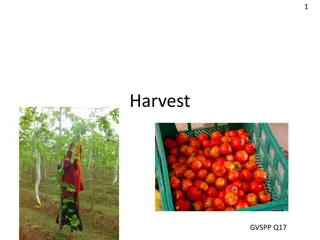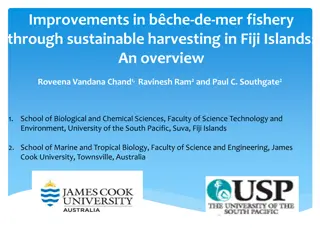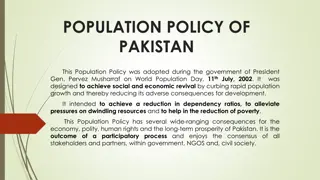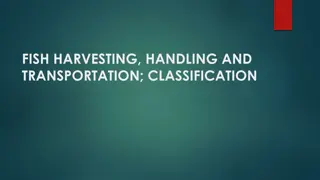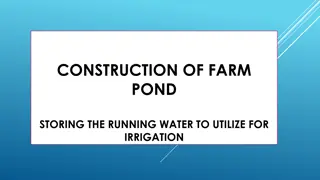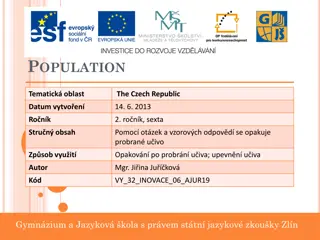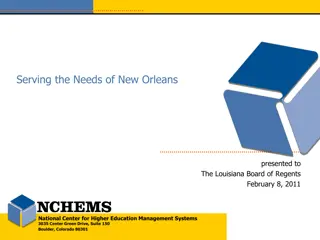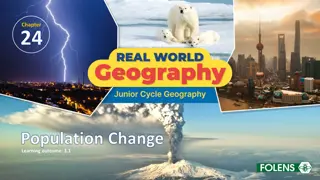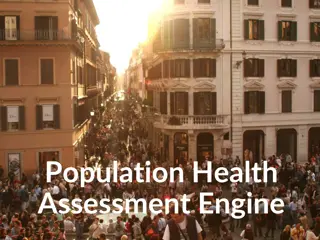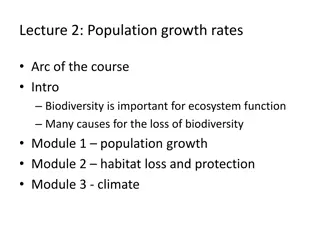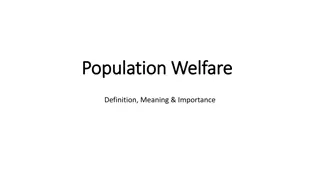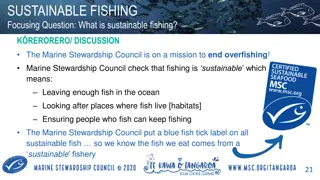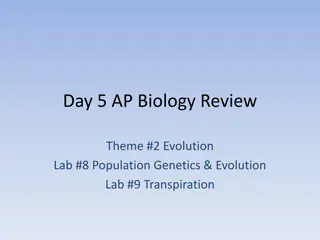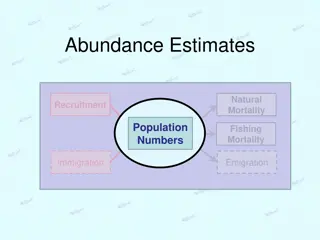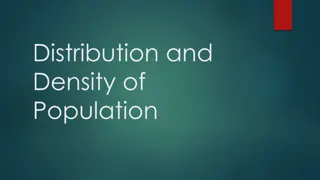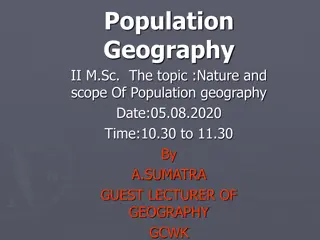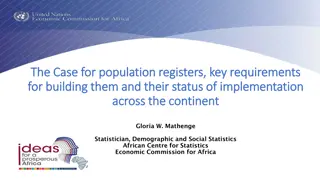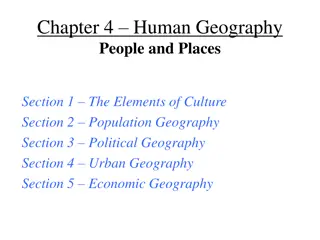Population Management and Sustainable Harvesting Strategies
Actual population numbers exhibit complex fluctuations influenced by predation and other factors. Understanding concepts like Maximum Sustainable Yield (MSY) and Minimum Viable Population (MVP) can help in managing populations effectively. The concept of MSY ensures the maximum harvest of a renewable resource without compromising its future availability. Predator-prey dynamics, such as Lynx and Hares, and Wolves and Moose, also contribute to population fluctuations. Maintaining populations at K/2 based on logistic growth curve can help sustain populations. Per capita growth rates and equilibrium conditions are key considerations in sustainable harvesting practices.
- Population Management
- Sustainable Harvesting
- Maximum Sustainable Yield
- Predator-Prey Dynamics
- Logistic Growth
Download Presentation

Please find below an Image/Link to download the presentation.
The content on the website is provided AS IS for your information and personal use only. It may not be sold, licensed, or shared on other websites without obtaining consent from the author. Download presentation by click this link. If you encounter any issues during the download, it is possible that the publisher has removed the file from their server.
E N D
Presentation Transcript
ESM221 Spring 2017 Lecture 6: population management Actual population numbers are messy and complex fluctuations and predation MSY maximum sustainable yield Processes that can lead to extinction MVP minimum viable population
Usually growth of natural populations is messier than model curves (though usually still generally fits w/ logistic model) Populations fluctuate Overshoot & Die offs (predicted by the logistic model) Variation around K due to Temp Fig 10.4, Cain et al. 2011, Ecology, Sinauer
Population fluctuations can also be caused by predator prey dynamics. E.g., Lynx and Hares
6-1 Draw a stylized predator-prey fluctuation
Maximum Sustainable Yield (MSY) Maximum sustainable yield: greatest harvest of a renewable resource that does not compromise the future availability of that resource. (pp 264-5) Why is this concept useful? How do you determine the level at which to harvest?
Maximum Sustainable Yield (MSY) Assumption: population growth is fastest at K/2 Theory: Use the logistic growth curve as the basis for a harvesting plan. To keep the population sustainable, try to maintain it at K/2.
Per capita growth rate Draw on board difference between Growth rate (dN/dt) Per capita growth rate -
Load and power http://web.pdx.edu/~rueterj/courses/objects/power-and-loading.html
Maximum Sustainable Yield H = rate of harvest The system is at equilibrium when the number of individuals removed is same as growth rate. For almost all harvest rates, there can be two pop sizes yielding the same growth rates, far from vs. close to carrying capacity
Maximum Sustainable Yield Problems Predicting the carrying capacity and the maximum growth rate in natural populations is difficult. These vary across time due to natural fluctuations. If calculated wrong, harvest often happens at the H3 level (see previous slide) rather than the H2 level. Harvest usually occurs at all size and age ranges but each of these can drastically affect current and future populations
6-2 Draw logistic growth curve Growth rate as a function of population Per capita growth rate as a function of population Identify where the MSY is
Avoiding extinctions Sustainability Pass on assets and choices to future generations Weak sustainability maximum assets Strong Sustainability requires that we pass on functioning biodiversity, natural capital
Factors that drive populations to extinction Deterministic (predictable) changes (e.g., overshoots of K, predator-prey;...) Fluctuations in population growth rate, due to variable environment or lags. Chance events Issues from Small population size (Allee effects, inbreeding )
Overshoots of K can cause fluctuation, even extinction. Why do some populations have sizes above K?
Factors that drive populations to extinction Deterministic (predictable) changes (e.g., overshoots of K, predator-prey;...) Fluctuations in population growth rate, due to variable environment or lags. Chance events Issues from Small population size (Allee effects, inbreeding )
Fluctuations in growth rate can drive populations, especially small ones, to extinction, with greater risk accompanying greater fluctuation. Q1. Why might growth rate fluctuate? If N0 = 10, r=0.2, growth rate std dev = 0.4, 17% of populations went extinct in 70 yrs. If st. dev = 0.8, 53% went extinct. [Std dev is a measure of variance.]
Delayed density dependence can cause populations to fluctuate in size. Density dependence: The size of the population (N) affects the population growth rate (dN/dt). Delay: # births is influenced by population densities from several time periods back (e.g., because resources grow at a different rate; predator reproduces more slowly than prey; delay before young come into the population or breed). Delayed density dependence: Delays in the effect that density has on population size; contributes to population fluctuations.
Factors that drive populations to extinction Deterministic (predictable) changes (e.g., overshoots of K, predator-prey;...) Fluctuations in population growth rate, due to variable environment or lags. Chance events Small population size (Allee effects, inbreeding )
The risk of extinction increases greatly for small populations because stochastic events cause population growth rates to fluctuate over time: Genetic drift Demographic stochasticity Environmental stochasticity
Population Extinction: Small populations are vulnerable to the effects of genetic genetic drift drift - - Chance events influence which alleles are passed on to the next generation 1.Loss of genetic variability reduces the ability of a population to respond to future environmental change. 2. Genetic drift can cause harmful alleles to occur at high frequencies.
Population Extinction: Small populations are vulnerable to problems from E Environmental stochasticity stochasticity nvironmental Unpredictable changes in the environment. Environmental variation that results in population fluctuation is more likely to cause extinction when the population size is small. Examples?
Chance events can strongly effect the size of small populations Environmental stochasticity: Changes in the average birth or death rates occur from year to year because of random changes in environmental conditions, including natural catastrophes. Demographic stochasticity: Population-level birth and death rates are constant within a year, but the fates of individuals differ. Heath hens (wikipedia commons) ~2000 hens on Martha s Vineyard in 1915; extinct in 1932
Factors that drive populations to extinction Deterministic (predictable) changes (e.g., overshoots of K, predator-prey;...) Fluctuations in population growth rate, due to variable environment or lags. Chance events Small population size (Allee effects, inbreeding )
Population Extinction: Small populations show a high frequency of I Inbreeding nbreeding Mating between related individuals. Inbreeding tends to increase the frequency of homozygotes, including those that have two copies of a harmful allele, which can lead to reduced reproductive success.
Genetic drift and inbreeding reduced the fertility of male lions in the Ngorongoro Crater 1962: biting flies reduced the population to 1 male, 9 females; Current pop from 15 lions
Population Extinction Allee effect per capita population growth decreases as population density decreases, which causes the population size to decrease even further. Allee effects occur because small groups are not as good at detecting predators, facilitating mutualistic species, or finding suitable mates nearby.
Allee effect: positive correlation between per capita growth rate and population size Population growth rate, dN/dt Population size, N Population with exponential growth Population with logistic growth Population that suffers an Allee effect when small
Allee effect: positive correlation between per capita growth rate and population size intraspecific competition decreases growth relative to exponential Population growth rate, dN/dt Population size, N Population with exponential growth Population with logistic growth Population that suffers an Allee effect when small
Allee effect: positive correlation between per capita growth rate and population size intraspecific competition decreases growth relative to exponential Population growth rate, dN/dt Allee effect: Decrease in growth rate due to problems in reproduction or defense based on small population size Population size, N Population with exponential growth Population with logistic growth Population that suffers an Allee effect when small
Allee effect: positive correlation between per capita growth rate and population size (or density). Per capita growth rate, dN/Ndt Decrease in growth rate between exponential & logistic growth, due to intraspecific competition r Allee effect: Decrease in growth rate when pops are small due to lowered reproduction or defense, based on the small population size Population size, N Population with exponential growth Population with logistic growth Population that suffers the Allee Effect when small but otherwise grows according to logistic growth K


